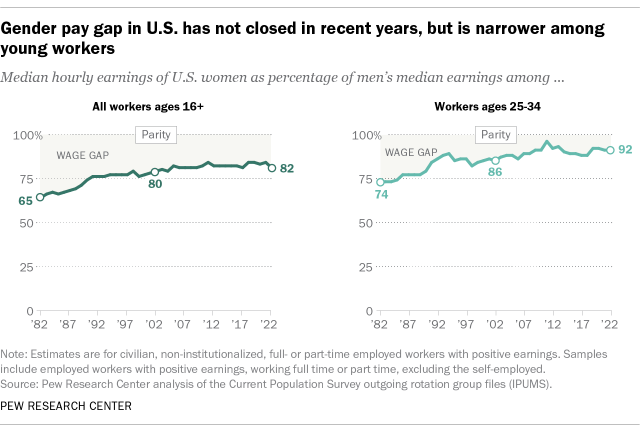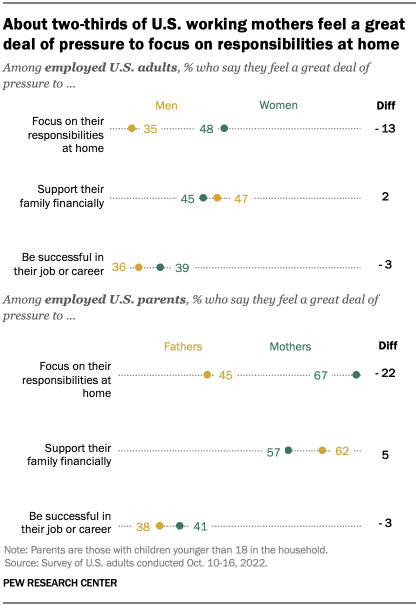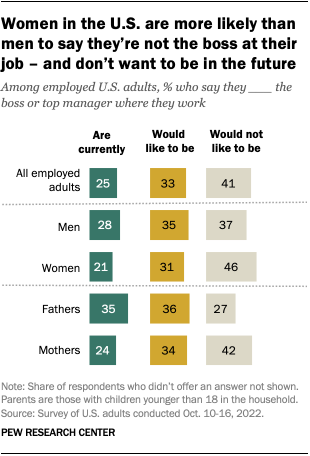The gender gap in pay has remained relatively stable in the United States over the past 20 years or so. In 2022, women earned an average of 82% of what men earned, according to a new Pew Research Center analysis of median hourly earnings of both full- and part-time workers. These results are similar to where the pay gap stood in 2002, when women earned 80% as much as men.

As has long been the case, the wage gap is smaller for workers ages 25 to 34 than for all workers 16 and older. In 2022, women ages 25 to 34 earned an average of 92 cents for every dollar earned by a man in the same age group – an 8-cent gap. By comparison, the gender pay gap among workers of all ages that year was 18 cents.
While the gender pay gap has not changed much in the last two decades, it has narrowed considerably when looking at the longer term, both among all workers ages 16 and older and among those ages 25 to 34. The estimated 18-cent gender pay gap among all workers in 2022 was down from 35 cents in 1982. And the 8-cent gap among workers ages 25 to 34 in 2022 was down from a 26-cent gap four decades earlier.
The gender pay gap measures the difference in median hourly earnings between men and women who work full or part time in the United States. Pew Research Center’s estimate of the pay gap is based on an analysis of Current Population Survey (CPS) monthly outgoing rotation group files (IPUMS) from January 1982 to December 2022, combined to create annual files. To understand how we calculate the gender pay gap, read our 2013 post, “How Pew Research Center measured the gender pay gap.”
The COVID-19 outbreak affected data collection efforts by the U.S. government in its surveys, especially in 2020 and 2021, limiting in-person data collection and affecting response rates. It is possible that some measures of economic outcomes and how they vary across demographic groups are affected by these changes in data collection.
In addition to findings about the gender wage gap, this analysis includes information from a Pew Research Center survey about the perceived reasons for the pay gap, as well as the pressures and career goals of U.S. men and women. The survey was conducted among 5,098 adults and includes a subset of questions asked only for 2,048 adults who are employed part time or full time, from Oct. 10-16, 2022. Everyone who took part is a member of the Center’s American Trends Panel (ATP), an online survey panel that is recruited through national, random sampling of residential addresses. This way nearly all U.S. adults have a chance of selection. The survey is weighted to be representative of the U.S. adult population by gender, race, ethnicity, partisan affiliation, education and other categories. Read more about the ATP’s methodology.
Here are the questions used in this analysis, along with responses, and its methodology.
The U.S. Census Bureau has also analyzed the gender pay gap, though its analysis looks only at full-time workers (as opposed to full- and part-time workers). In 2021, full-time, year-round working women earned 84% of what their male counterparts earned, on average, according to the Census Bureau’s most recent analysis.
Much of the gender pay gap has been explained by measurable factors such as educational attainment, occupational segregation and work experience. The narrowing of the gap over the long term is attributable in large part to gains women have made in each of these dimensions.
Related: The Enduring Grip of the Gender Pay Gap
Even though women have increased their presence in higher-paying jobs traditionally dominated by men, such as professional and managerial positions, women as a whole continue to be overrepresented in lower-paying occupations relative to their share of the workforce. This may contribute to gender differences in pay.
Other factors that are difficult to measure, including gender discrimination, may also contribute to the ongoing wage discrepancy.
Perceived reasons for the gender wage gap

When asked about the factors that may play a role in the gender wage gap, half of U.S. adults point to women being treated differently by employers as a major reason, according to a Pew Research Center survey conducted in October 2022. Smaller shares point to women making different choices about how to balance work and family (42%) and working in jobs that pay less (34%).
There are some notable differences between men and women in views of what’s behind the gender wage gap. Women are much more likely than men (61% vs. 37%) to say a major reason for the gap is that employers treat women differently. And while 45% of women say a major factor is that women make different choices about how to balance work and family, men are slightly less likely to hold that view (40% say this).
Parents with children younger than 18 in the household are more likely than those who don’t have young kids at home (48% vs. 40%) to say a major reason for the pay gap is the choices that women make about how to balance family and work. On this question, differences by parental status are evident among both men and women.
Views about reasons for the gender wage gap also differ by party. About two-thirds of Democrats and Democratic-leaning independents (68%) say a major factor behind wage differences is that employers treat women differently, but far fewer Republicans and Republican leaners (30%) say the same. Conversely, Republicans are more likely than Democrats to say women’s choices about how to balance family and work (50% vs. 36%) and their tendency to work in jobs that pay less (39% vs. 30%) are major reasons why women earn less than men.
Democratic and Republican women are more likely than their male counterparts in the same party to say a major reason for the gender wage gap is that employers treat women differently. About three-quarters of Democratic women (76%) say this, compared with 59% of Democratic men. And while 43% of Republican women say unequal treatment by employers is a major reason for the gender wage gap, just 18% of GOP men share that view.
Pressures facing working women and men
Family caregiving responsibilities bring different pressures for working women and men, and research has shown that being a mother can reduce women’s earnings, while fatherhood can increase men’s earnings.

Employed women and men are about equally likely to say they feel a great deal of pressure to support their family financially and to be successful in their jobs and careers, according to the Center’s October survey. But women, and particularly working mothers, are more likely than men to say they feel a great deal of pressure to focus on responsibilities at home.
About half of employed women (48%) report feeling a great deal of pressure to focus on their responsibilities at home, compared with 35% of employed men. Among working mothers with children younger than 18 in the household, two-thirds (67%) say the same, compared with 45% of working dads.
When it comes to supporting their family financially, similar shares of working moms and dads (57% vs. 62%) report they feel a great deal of pressure, but this is driven mainly by the large share of unmarried working mothers who say they feel a great deal of pressure in this regard (77%). Among those who are married, working dads are far more likely than working moms (60% vs. 43%) to say they feel a great deal of pressure to support their family financially. (There were not enough unmarried working fathers in the sample to analyze separately.)
About four-in-ten working parents say they feel a great deal of pressure to be successful at their job or career. These findings don’t differ by gender.
Gender differences in job roles, aspirations

Overall, a quarter of employed U.S. adults say they are currently the boss or one of the top managers where they work, according to the Center’s survey. Another 33% say they are not currently the boss but would like to be in the future, while 41% are not and do not aspire to be the boss or one of the top managers.
Men are more likely than women to be a boss or a top manager where they work (28% vs. 21%). This is especially the case among employed fathers, 35% of whom say they are the boss or one of the top managers where they work. (The varying attitudes between fathers and men without children at least partly reflect differences in marital status and educational attainment between the two groups.)
In addition to being less likely than men to say they are currently the boss or a top manager at work, women are also more likely to say they wouldn’t want to be in this type of position in the future. More than four-in-ten employed women (46%) say this, compared with 37% of men. Similar shares of men (35%) and women (31%) say they are not currently the boss but would like to be one day. These patterns are similar among parents.
Note: This is an update of a post originally published on March 22, 2019. Anna Brown and former Pew Research Center writer/editor Amanda Barroso contributed to an earlier version of this analysis. Here are the questions used in this analysis, along with responses, and its methodology.

What is the gender wage gap in your metropolitan area?
Find out with our pay gap calculator



